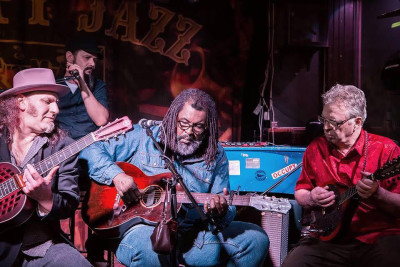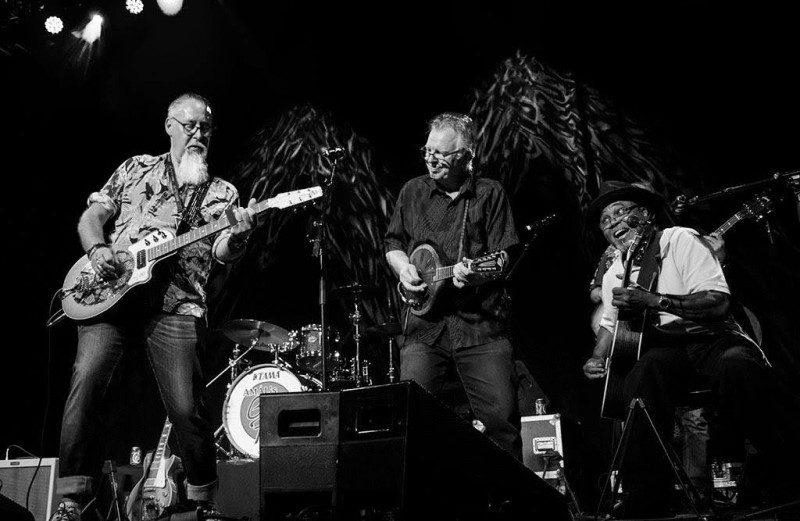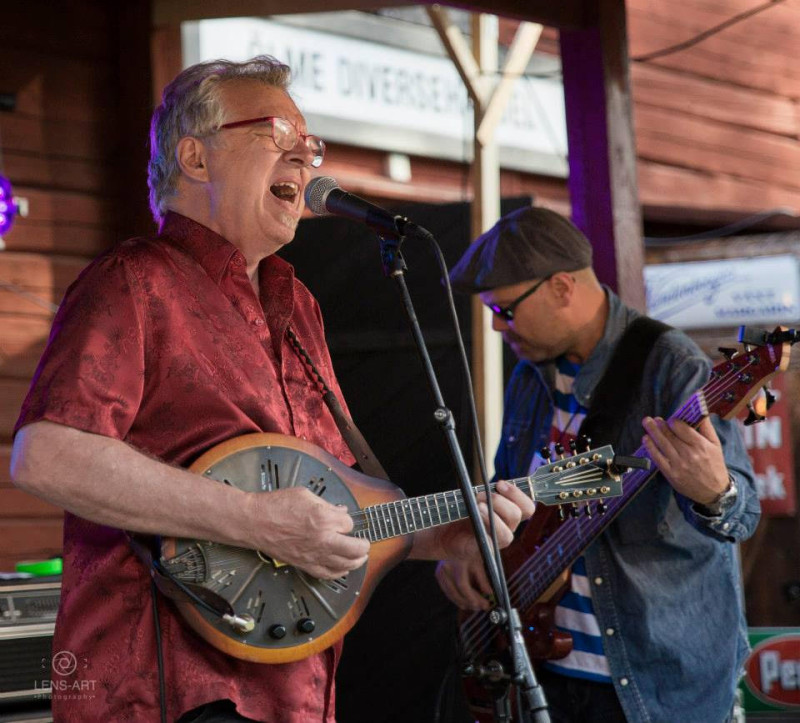
The mandolin was an important blues instrument in the golden era of the blues, used in bands like Memphis Jug Band and the Mississippi Sheiks. Vol Stevens, Will Weldon, Eddie Dimmitt and Charlie McCoy were some of the best at the time. At the Stovall plantation in Mississippi Muddy Waters played with mandolinist Louis Ford. Later, Muddy played with mandolinist Johnny Young in Chicago’s Southside. Of course, the famous Yankel Rachel was a key element in Sleepy John Estes ensemble. Today, a few carry on the tradition: Rich Del Grosso, Ry Cooder, Steve James, Andra Fay, Billy Flynn and others. One of them is Bert Deivert in Karlstad, Sweden, which is halfway between Stockholm and Oslo, Norway.
thecountryblues.com caught up with the musico via phone, a few days before he was to welcome Louisiana guitarist Libby Rae Watson to Sweden for a joint performance at a local festival. Bert Deivert told us his story:
“I started singing when I was a kid, and I used to sing in choirs. Then I saw the Beatles on TV in 1964 when I was 13. I wanted to started playing so I started playing drums in garage bands in 1965. I started playing guitar later on in 1965. I used to borrow my brother’s guitar. So I’ve been playing blues since ’66 and all kinds of folk music and things like that. I started being a professional musician in 1973.
I saw Son House on TV when I was 16, and that’s what kind of started me on the country blues. I was just totally knocked out by it. I didn’t really know very much about it and I started looking around and finding records and songs that had been written by rock artists that were by older guys like Skip James. But I didn’t know anybody playing this kind of music. When I went to the university in 1968, I started working at the radio station, and they had a fantastic archive of good music so I found out a lot more about this kind of music and started playing more blues and folk music. But in Sweden I wasn’t able to make a living on blues, so it became a mixture of folk music, my own original songs and different things. I hooked up with a lot of different musicians here. In 1973, I was a street musician in San Francisco, playing around sort of homeless for a while. But I used to play with Peter Case, who also plays blues. He is still based in San Francisco now. From ’74, I played a folk music of different kinds and blues. One of the first guys I hooked up with was Eric Bibb. He was also an expat living here in Sweden, and I saw him in a concert in 1975 or ’76, and chatted with him and found out we were on the same record company in 1978. We made three duo albums in the early ‘80s, which are out of print now, on an audiophile label called OPUS 3. The first one was made on April Fool’s Day in 1979, and was called April Fools. The second one was RiverRoad. The third one was called Hello Stranger. River Roadwas a mix of the black and the white string band music, old country blues, old-timey and a few of own songs. Hello Stranger was mostly Gary Davis, New Lost City Ramblers, Blind Alfred Reed – you know, bringing our own specific sort of feel upon the side of the music that we’re familiar with. River Road is a fantastic record.
Eric lived up in Stockholm and I lived way out in the country, so we didn’t see each other very much. We only actually did one live gig for national radio once, and he was backing up a singer named Cindy Peters in Stockholm. I just made a living on my music for about 20 years just plugging away, always playing blues, but not as the main way of making a living.
I am actually a guitar player who started to learn how to play mandolin seriously in 2003. I was crazy about Yank Rachell from 1973, when Peter Case had an album with him on Delmark called Broke and Hungry with Yank Rachell and Sleepy John, and Mike Bloomfield was on a session, Big Joe Williams. I just couldn’t believe the sound. I was knocked out. And then later I found the album in Sweden and bought it. But I never really knew how to play mandolin. I had one around, just a cheap one, just to have for chords, to play as this sort of different sonic thing when you’re doing stuff. So I used it on a couple of Eric and my albums, where I just learned how to play one little tiny melody line and the chords. But I started deciding that I’m going to learn how to play, so I sat for two years and just listened to everything that Yank Rachell played. So, by 2005-2006, I was starting to get pretty good on it, and I made a – started working with a friend of mine here that I played with since ’85, a Swedish guy, Janne Zander.
I got tinnitus in 1995 really bad. I have to use earplugs constantly, even for playing acoustically, if somebody else’s is it’s too loud for my ears. I learned as much as I could, and I started contacting all the people that were playing blues mandolin exclusively around the world. I was in touch with Rich DelGrosso, Billy Flynn, Jimi Hocking in Australia, Jim Richter in Indianapolis.
Rich DelGrosso came over here and played with me. I was in Australia and played with Jimi Hocking in Katmandu, at the Himalayan a blues fest. I just got in touch with this younger guy named Lino Muoio from Italy, who plays with Corey Harris.

My gig at the present time is just blues mandolin and guitar. Brian Kramer, an American, lives a bit north of here. He and I played together on tours in Russia, Estonia, Finland. In New York he made an album with Mick Taylor, Junior Wells and some other people there.
I get a pension from the Swedish government because I’m 68 years old, but I’m still actively playing and touring. I’ve gone every year to Thailand for about 10 years and played with bands there and made an album. We won two prizes for best instrumental in Thailand with a Thai composer using a blues mandolin, which is pretty unusual. And I’ve got my best record release ever from the album that’s being sold there. Charlie Musselwhite is in on that album 13 Samsen. It is a mix of blues and Thai folk musicSome blues tunes and some original –the other ones are original tunes we’ve written. But it brings in blues, Thai folk music and other stuff in a kind of interesting.
I made 12 albums. The blues mandolin albums are available: Takin’ Sam’s Advice and Kid Man Bluesand Bert Deivert & Copperhead Run.
One of my best musical memories is going to Mississippi. I always wanted to go there since I saw Son House on TV, but never had the money to do it. Living in Sweden and making a meager amount of money with the blues, just being able to live on and have a family here didn’t allow me to travel that much. I went to Mississippi in 2007, and I met up with a great guy named Bill Abel, a great musician from Belzoni. Bill and I met at the Honey Boy Edwards concert for the Muddy Waters Blues Trail marker. He was just a great guy, and I started playing with him, and he introduced me to some other guys – T-Model Ford and Cadillac John Nolden, and we started playing with them. He introduced me to Sam Carr, who is on the Kid Man Bluesalbum. I met a lot of really nice people in Mississippi – Jimmy “Duck” Holmes, Red at Clarksdale – Red’s Blue’s place. Terry Bean, Robert Belfour– all these people I heard about I got to meet and play with a lot of them T-Model and Cadillac John and Bill also did some gigs in Sweden. One time, Bill Abel and Cadillac John Nolden and I were playing at a school in Mississippi, and after we finished John leaned over to me and said, “I like the way you play that thing. You play that old style!” To me, that meant a lot. The old style is what inspired me to start playing!
I remember sitting in the front yard at T-Model’s house in 2008, and his van was parked there and he’s pulled out some chairs. Kids were playing around. So, I said to T-Model, “T-Model, you got any kids?” He goes, “They say I got 26 of them.” I was like, whoa. I couldn’t believe that.

I really have been trying to keep blues mandolin going, because my hero on blues mandolin is Yank Rachell and also Carl Martin. I would say those are the two that have had the most effect on my playing, and on who I’ve sort of modeled my playing from and then keep on going.
Last night at the gig a guy came up and said, “Wow, I don’t like blues, but I really like this. What is this? This isn’t blues, is it?” I say, “Yeah.” And they say, “Why you play a bluegrass instrument in blues?” I say, “Well, the mandolin has been used since the turn of the century between the 1900s and 1800s in old-time string band music. It’s been used in blues since then. Bluegrass was invented in 1945 or so.”
To me, to raise this sort of consciousness that blues mandolin is really important. A lot of blue musicians – even country blues players – have never heard blues mandolin. I talked to Sam Carr – he was Robert Nighthawk’s son – he played drums with us. When I was playing blues mandolin, in the Yank Rachel style he said, “Hey, when are you all going to start playing blues? You’re all playing country.” Because he was used to the shuffle, Chicago blues – he played with his dad and he played with Houston Stackhouse and a lot of different people.
I just got a new mandolin. I just happened to run across violin maker David Šefl. I have always wanted a mandolin with a black top and amber body with a little bit of a different modern style so I can reach higher notes without a problem. David and I exchanged notes and images of mandolins and he came up with a great design that I could use with an acoustic pickup built inside. It is now on its way here and I will be using it at gigs with Libby Rae Watson this summer.
Interestingly, when I play the Bentonia style of blues, it reminds me a bit of Swedish music. When I play northern Thai folk music – it’s got that minor Bentonia blues kind of thing in it too.
I can just say in closing that this is the music that I love, and even though I’ve written a lot of songs and things before, I really want to keep a lot of these songs and this playing style alive, and I’ll just be continuing this as long as I can: play and live. It’s just – it’s my passion.”
